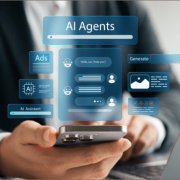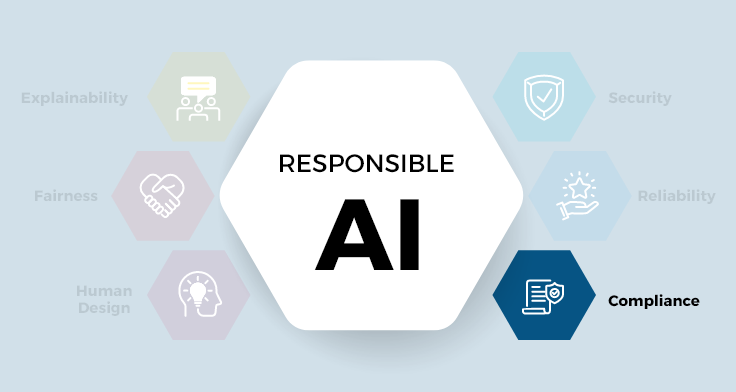Artificial intelligence (AI) has become increasingly integral to the way we live our lives, providing innovative solutions to complex challenges and transforming various sectors. However, the rapid growth of AI also raises concerns around issues such as data privacy, regulatory compliance, and the ethical use of data. As a result, having a responsible AI framework in place is vital for organizations to ensure trustworthiness and transparency in their AI systems.
In this blog, we will delve into two critical aspects of the compliance component of a responsible AI framework:
- Ensuring data is acquired fairly, with consent, and in compliance with privacy laws.
- Ensuring regulatory and privacy law compliance for users affected by AI recommendations.
Ensuring Fair Data Acquisition with Consent, and Compliance
- Fair Data Acquisition
The foundation of robust AI solutions is the quality and the method of acquiring the data used for the training and validation of algorithms. Ensuring fair data acquisition means collecting data by adhering to principles that prevent discrimination, promote inclusiveness, and consider user consent.
- The Role of Data Diversity
Creating inclusive AI models starts with gathering diverse data sets that represent different demographic groups, regions, and contexts. Ensuring this diversity helps prevent algorithms from favoring any particular group and maintains fairness across the AI system.
- Mitigating Bias
Since AI models depend on the quality and characteristics of the input data, they can inherit biases present in the data. Bias in AI systems may lead to unfair results, reinforcing existing stereotypes or discriminating against certain populations. Organizations should take active steps to identify, assess, and mitigate potential biases in the data collection process.
- Data Acquisition with Consent
Consent is a vital aspect of acquiring data fairly. Users must be both informed about and explicitly agree to their data’s collection, use, and storage. Consent must be specific, freely given, and easily revocable by the data subject.
- Privacy-By-Design Approach
Taking a privacy-by-design approach means considering privacy and data protection throughout the entire data lifecycle, from collection to disposal. This approach allows organizations to incorporate privacy measures directly into AI system designs, ensuring compliance with data protection regulations.
- Compliance with Privacy Laws
AI development has led to an increased emphasis on data privacy laws around the world. As a result, organizations must ensure that data acquisition practices align with applicable privacy regulations, such as GDPR in Europe or CCPA in California. Compliance necessitates transparency with users, obtaining appropriate consent, and only using data within the terms of these agreements.
Regulatory and Privacy Law Compliance for Users Affected by AI Recommendations
The impact of AI technologies on everyday life can be profound. As AI-driven tools increasingly provide recommendations affecting people’s jobs, healthcare, and more, ensuring regulatory and privacy law compliance becomes especially crucial.
- Monitoring and Evaluation
Constant monitoring and evaluation of AI systems can help organizations identify potential biases, ensure the accuracy of AI recommendations, and comply with regulations. Methods such as auditing models, reviewing inputs, and analyzing outputs can enable businesses to detect and correct any AI recommendation that does not align with compliance and ethical standards.
- Transparency and Explanations
Given that AI systems’ recommendations affect users, it’s essential to make AI algorithms transparent and explainable. Providing users with clear reasons behind AI recommendations helps promote trust in the technology and allows users to understand the data processing and factors considered when reaching a conclusion.
- Data Protection and Privacy of Affected Users
The protection of users’ privacy and personal data is a cornerstone of regulatory compliance. Implementing strong data protection practices and giving users control over their personal information can help organizations respect user privacy and balance the benefits of AI technology with its potential risks.
- Anonymization Techniques
Effective anonymization techniques can help organizations protect user privacy by stripping data of identifying information, while still using it to inform AI models. Methods such as differential privacy or tokenization can support businesses in maintaining compliance while still benefiting from AI’s potential.
- Legal Compliance in AI-driven Decision-making
AI-driven recommendations may have substantial legal ramifications, particularly in specific sectors like finance, healthcare, and employment. Organizations need central AI governance frameworks to oversee models’ compliance with sector-specific regulations and address potential ethical tensions.
In Summary…
The adoption of AI technologies has the potential to unlock enormous societal and economic benefits. However, to maximize these benefits and minimize risks, businesses must work tirelessly to ensure that their AI systems are developed and deployed responsibly.
The compliance component of a responsible AI framework focuses on fair data acquisition practices, obtaining consent, and upholding privacy and regulatory standards. By embedding compliance and ethical principles at the core of AI system design, organizations can thrive in the AI landscape, nurture users’ trust, and deliver positive outcomes for all stakeholders.
To explore the other parts in this series, click here.
Recent Blogs

The Future of Supply Chains Is AI-Driven—Is Your Business Ready to Embrace the Change?
July 2, 2025

What Retail Media Can Learn from Instacart’s AI Strategy
June 24, 2025

Beyond Chatbots: How Agentic AI Is Automating High-Stakes Business Decisions
June 11, 2025

From Batch to Real-Time: The Future of Data Distribution Using Databricks Delta Sharing
June 4, 2025


